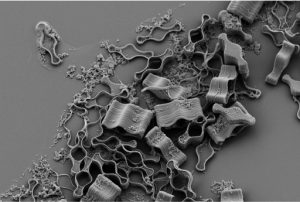In this post, Alexander Feckler talks about their recently published paper “Blinded by the light: increased chlorophyll fluorescence of herbicide-exposed periphyton masks unfavorable structural responses during exposure and recovery”.
Periphyton – that is biofilms containing algae, heterotrophs, and associated detritus – is paramount for the ecosystem functioning in surface waters as a high-quality food source and for oxygen, carbon, and nutrient cycling. At the same time, periphyton is subjected to multiple stressors, for instance herbicides that have been identified as the substance class exhibiting the highest risk to algae and thus the algal component of periphyton. Herbicide effects on periphyton are frequently studied, however, so far the focus has been on photosynthesis-inhibiting herbicides whereas other modes of toxic action were mostly ignored. Inhibition of carotenoid biosynthesis, for instance, has the potential to indirectly affect periphytic health and functioning, as these pigments prevent photooxidation of chlorophylls – the ‘motor’ of photosynthesis – and hence ensure the photosynthetic activity.

Scanning electron microscope image of Tabellaria flocculosa, a benthic algae (image by S. Gonçalves)
We, therefore, tested if a carotenoid-biosynthesis-inhibiting herbicide has the potential to affect periphyton’s structure with subsequent effects on its functioning. To this end, we conducted a 21-days-lasting lab experiment, during which periphyton was exposed to the herbicide diflufenican for 12 days followed by 9 days of recovery in herbicide-free medium. During both exposure and recovery phase, periphyton’s structural components (pigment concentration, biomass, and algal structure) as well as photosynthetic efficiency were monitored.
Not surprisingly, herbicide exposure had detrimental effects on the photosynthetic apparatus of algae, however, these adverse structural effects were not reflected in the functioning, as the photosynthetic efficiency – judged on chlorophyll fluorescence – was increased. Although some of the monitored structural variables were on their trajectories to recover from the adverse conditions during the recovery phase of the experiment, it remains questionable if periphyton is able to quickly recover from stress due to the persistence of functional effects.
Our results demonstrate that herbicide modes of toxic action other than direct photosynthesis-inhibition can adversely affect the algal component of periphyton over the long term. As a consequence, the continuing maintenance of primary production and photosynthesis may be questioned, which points towards a shift to a higher degree of heterotrophy of the periphyton with consequent shifts in ecosystem functioning.
The paper was authored by Alexander Feckler, Jelena Rakovic, Maria Kahlert, Rikard Tröger, and Mirco Bundschuh, and published in Aquatic Toxicology.
